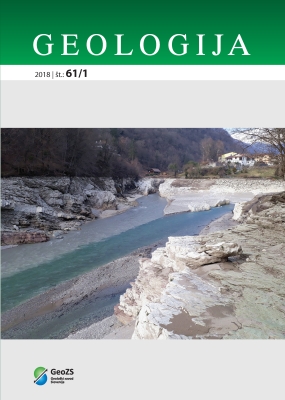Calcite deformation twins in Pohorje marbles
DOI:
https://doi.org/10.5474/geologija.2018.005Abstract
Marbles in Pohorje occur in lenses and smaller bodies in the southern and southeastern part of the massif. Marbles are very pure, predominantly calcitic and rarely calcitic-dolomitic, containing a maximum of 5 % of non-carbonate mineral phases. The latter comprise pyroxenes (diopside), amphiboles (tremolite), olivines (forsterite) in places replaced by serpentine, quartz, feldspars (potassium feldspars and plagioclases), epidote, zoisite, vesuvianite, scapolite, muscovite, biotite partly replaced by chlorite, phlogopite, rare grains of titanite, rutile, zircone, apatite, and small grains of ferric oxides and sulfides. Calcite exhibits intensive deformational e-twinning whereas dolomite is undeformed and untwined. All four known types of mechanical twins in calcite were recognized: thin Type I twins, straight thick Type II twins, curved, lensoid and tapered thick Type III twins, and thick patchy Type IV twins. Type III twins are the dominant mechanical twins in the Pohorje marbles indicating the temperature of deformation somewhat above 200 °C. Since they lack signs of grain boundary recrystallization, we assume that the twinning was followed by a decrease temperature during exhumation. With increasing temperature the process of recrystallization along calcite grain becomes pronounced. Small individual untwined calcite crystals are progressively replacing bigger calcite grains. In few examples second generation of Type I deformational twins develop in recrystallized calcite grains, which also implies lowering of temperature due to exhumation.Downloads
How to Cite
Vrabec, M., Rogan Šmuc, N., & Vrabec, M. (2018). Calcite deformation twins in Pohorje marbles . Geologija, 61(1), 73–84. https://doi.org/10.5474/geologija.2018.005
Issue
Section
Articles

